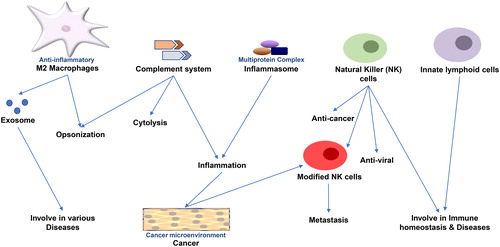Host immunity ensures protection against a foreign intrusion having the potential to disrupt the physiological balances of the host. Innate immunity is a first line of defense and is instrumental in the development of appropriate defense against infection. However, overactivation of innate immune components results in immunopathogenesis. The family of proteins, known as complement protein, constitute complement system and participates in development of inflammation and elimination of the target pathogenic microbial cells by specialized immunological processes. Another family of proteins involved in innate immune defense are anti-microbial proteins or peptides. These proteins or peptides either directly act on target cells or facilitate elimination through recruitment of appropriate immune cells. The cellular components of innate immunity such as macrophages, dendritic cells and natural killer cells are first responders to any foreign intruders and initiate a sequence of primary responses including phagocytosis, or direct killing of modified self (tumor or cancerous) cells or inducing inflammation via various inflammatory mediator through complex cellular signaling pathways. A specialized immune cell known as innate lymphoid cells of lymphoid lineage playing an important role on mucosal surfaces in immune regulation to maintain immune homeostasis. This issue of International Reviews of Immunology focuses on articles discussing cellular and humoral components in development of disease and manipulation of innate immune signaling pathways for the development of possible immunotherapeutics ().
A group of thermolabile complement protein synthesized by hepatocytes play an essential role in host defense. The complement system activates through three distinct pathways namely classical, alternative and lectin pathway, in presence of microbial pathogen. The classical system activates through formation of antigen-antibody complex whereas alternative and lectin pathway can activate spontaneously and through sugar-binding lectin protein, respectively. The functional outcome of these pathways is to induce inflammation, cytolysis, and facilitate phagocytosis of the target cells. The first review article in this issue by Romano et al. discusses the biology of complement family proteins and its role in pathogen clearance. The article particularly provides an insight on dysregulated components of complement system, either deficiency or overactivation and its impact on physiology or development of immunopathology such as severe systemic infection or autoimmune diseases. The article also discusses old and current diagnostic methods and various therapeutic approaches [Citation1]. This article will be interesting to the clinician and researchers working in basic and translational immunology for the development of better diagnostics and therapeutics ().
Among all cancers, lung cancer is most common cause of death globally. Cigarette/tobacco smoking and passive inhalation of smoke by nonsmokers may cause lung cancer. Additionally, chronic and persistent inflammation in lung tissues through various signaling pathways can also promote oncogenesis. Lung cancer has two major types, the non-small cell lung cancer (NSCLC) and small cell lung cancer (SCLC); NSCLC is more fatal. The host immunity plays a critical role in controlling the transformed cells through recruitment of immune cells such as natural killer cells and subsets of T cells. The second review in this issue by Sarkar et al. discusses the role of NOD-like receptor (NLR)-mediated innate immune signaling pathway, particularly the multiprotein complex known as inflammasome in lung cancer pathogenesis. The article also highlights manipulation of inflammasome as a possible therapeutic approach [Citation2]. This article will be interesting to onco-immunologists, pharmacologists, and related scientists ().
Macrophages are phagocytic cells and one of the key players of immunity that links innate and adaptive immunity through the secretion of soluble cytokines and expression of MHC molecules needed for the activation of T cells. The Macrophages are functionally differentiated into M1 and M2 macrophages. M1 macrophages promote inflammation and M2 macrophages dampen the inflammation. The third review article of this issue by Hou et al. describes the exosomes derived from M2 macrophages and its role in disease pathogenesis. The article also discusses the potential to target exosome in disease manipulation [Citation3]. This article will be helpful to cell biologists, cellular immunologists, and other related disciplines of immunology ().
Natural killer (NK) cells are pivotal for innate immunity against virus infection and tumor cells. NK cell recognizes the tumor cells and kill them by introducing toxic granule containing perforin and granzyme into the target tumor cells. In return tumor cells also provide a microenvironment to NK cells to change its properties. The modified NK cells instead of killing tumor cells, it starts spreading tumor cells or promote metastasis. The fourth review article of this issue by Arianfar et al. focuses on NK cells and breast cancer cell interaction. The authors provide the mechanistic insight of NK cells suppression in tumor microenvironment and discuss a few molecular manipulations that could be the potential immunotherapeutic strategy for the breast cancer [Citation4]. The article will be useful to the onco-immunologist and oncologist.
Innate lymphoid cells (ILCs) are recently discovered lymphoid linage innate immune cells present on various mucosal surfaces/tissues of the host. Based on cytokine production and immune function, there are four types. ILCs are important in maintaining immune homeostasis, tissue repair, and infections at mucosal surfaces and deep in tissues. ILCs are also involved in different kinds of hypersensitivity reactions such as allergic reaction, asthma, and development of autoimmune diseases. The last article in this issue by Kumar et al. discusses the role of ILCs in different physiological settings and communication of ILCs between adaptive immune components [Citation5]. This article will be interesting to broad readers of basic and translational immunologists ().
References
- Complement system network in cell physiology and in human diseases. Int Rev Immunol 2021;40(3):159–170. doi:10.1080/08830185.2021. 1833877.
- Manipulation of Inflammasome: A promising approach towards Immunotherapy of Lung Cancer. Int Rev Immunol 2021;40(3):171–182. doi:10.1080/08830185.2021. 1876044.
- The Novel Target: Exosomes derived from M2 Macrophages. Int Rev Immunol 2021;40(3):183–196. doi:10.1080/08830185.2021. 1800687.
- Natural Killer Cell Defects in Breast Cancer: A Key Pathway for Tumor Evasion. Int Rev Immunol 2021;40(3):197–219. doi:10.1080/08830185.2021. 1845670.
- Innate lymphoid cells and adaptive immune cells cross-talk: a secret talk revealed in immune homeostasis and different inflammatory conditions. Int Rev Immunol 2021;40(3):217–251. doi:10.1080/08830185.2021. 1895145.

